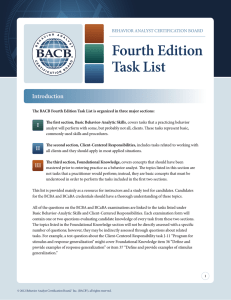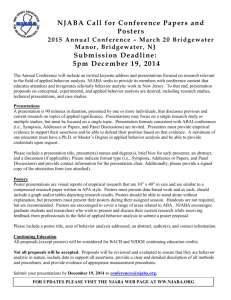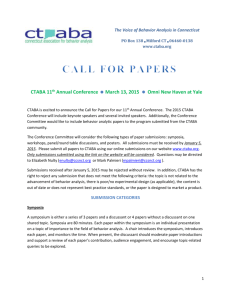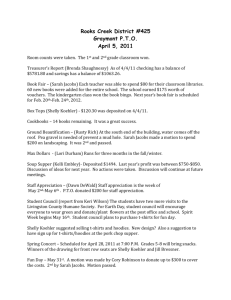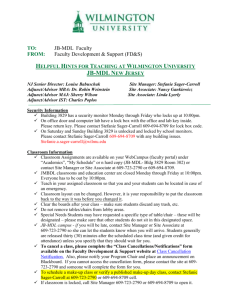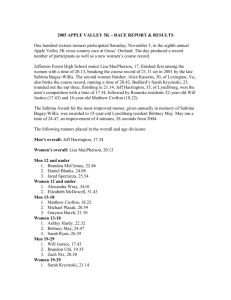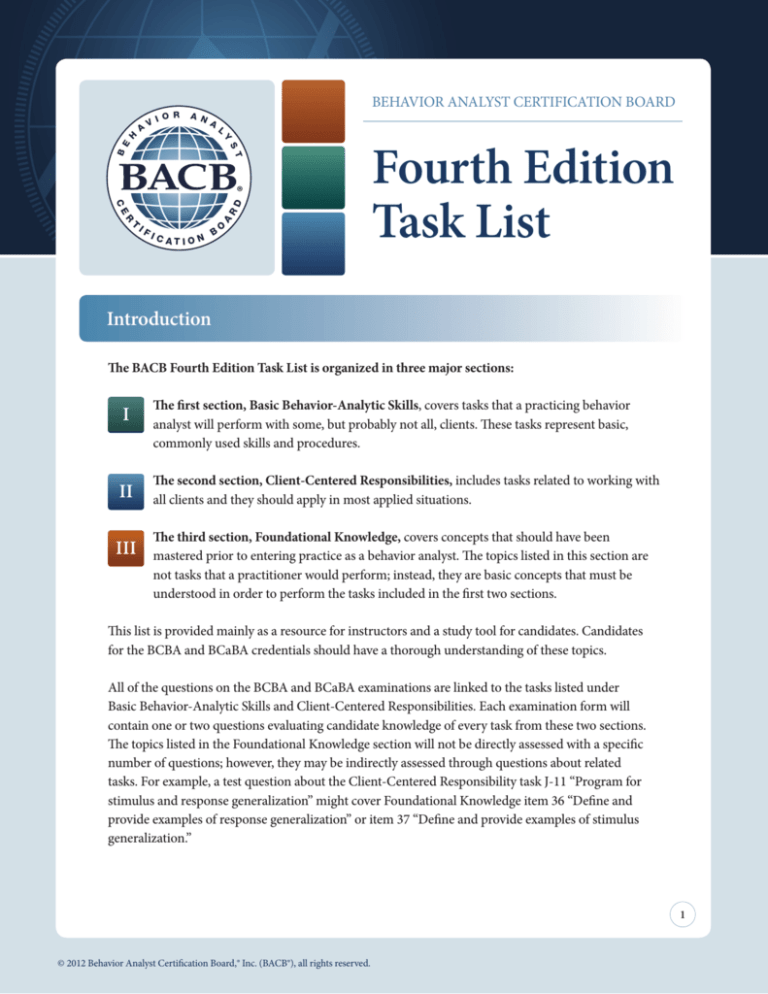
T
®
R
IF
IC
AT I O N
O R
V I
O
B
A N
A
BEHAVIOR ANALYST CERTIFICATION BOARD
L
T
B
S
E
Y
H
A
A
R
D
CE
T
®
R
IF
A
R
D
CE
T
IC
AT I O N
B
Stefanie Koehler Designs_BACB_113011
O
Fourth Edition
Task List
BACB LOGO VECTOR MASTER FILE
CONTACT :: Stefanie Koehler • stefanie.m.koehler@gmail.com • 604-563-9412 • Vancouver, BC, Canada
Introduction
The BACB Fourth Edition Task List is organized in three major sections:
I
II
III
The first section, Basic Behavior-Analytic Skills, covers tasks that a practicing behavior
analyst will perform with some, but probably not all, clients. These tasks represent basic,
commonly used skills and procedures.
The second section, Client-Centered Responsibilities, includes tasks related to working with
all clients and they should apply in most applied situations.
The third section, Foundational Knowledge, covers concepts that should have been
mastered prior to entering practice as a behavior analyst. The topics listed in this section are
not tasks that a practitioner would perform; instead, they are basic concepts that must be
understood in order to perform the tasks included in the first two sections.
This list is provided mainly as a resource for instructors and a study tool for candidates. Candidates
for the BCBA and BCaBA credentials should have a thorough understanding of these topics.
All of the questions on the BCBA and BCaBA examinations are linked to the tasks listed under
Basic Behavior-Analytic Skills and Client-Centered Responsibilities. Each examination form will
contain one or two questions evaluating candidate knowledge of every task from these two sections.
The topics listed in the Foundational Knowledge section will not be directly assessed with a specific
number of questions; however, they may be indirectly assessed through questions about related
tasks. For example, a test question about the Client-Centered Responsibility task J-11 “Program for
stimulus and response generalization” might cover Foundational Knowledge item 36 “Define and
provide examples of response generalization” or item 37 “Define and provide examples of stimulus
generalization.”
1
© 2012 Behavior Analyst Certification Board,® Inc. (BACB®), all rights reserved.
®
R
IF
IC
AT I O N
O R
V I
O
B
A N
A
L
T
B
S
E
Y
H
A
A
R
D
CE
T
®
R
IF
A
R
D
CE
T
IC
AT I O N
B
Stefanie Koehler Designs_BACB_113011
O
BACB LOGO VECTOR MASTER FILE
CONTACT :: Stefanie Koehler • stefanie.m.koehler@gmail.com • 604-563-9412 • Vancouver, BC, Canada
Ethics and Professional Conduct are subsumed within each section of the task list. The BACB
Professional Disciplinary and Ethical Standards and Guidelines for Responsible Conduct for Behavior
Analysts are essential companion documents to the task list. BACB certificants must practice in
compliance with the professional disciplinary and ethical standards and should structure their
practices in accordance with the conduct guidelines. Candidates are expected to have a complete
understanding of these documents, including, but not limited to, the importance of ethical conduct
as it relates to professional practice of the tasks identified in the Fourth Edition Task List. As a result,
questions addressing ethical issues related to specific tasks will appear on the examination.
2
T
B
S
E
Y
H
L
®
R
IF
IC
AT I O N
O R
V I
O
B
A N
A
Y
T
B
S
E
Section I:
Basic Behavior-Analytic Skills
L
H
A
A
R
D
CE
T
®
R
IF
A
R
D
CE
T
IC
AT I O N
B
Stefanie Koehler Designs_BACB_113011
O
BACB LOGO VECTOR MASTER FILE
CONTACT :: Stefanie Koehler • stefanie.m.koehler@gmail.com • 604-563-9412 • Vancouver, BC, Canada
A. Measurement
A-01
Measure frequency (i.e., count).
A-02
Measure rate (i.e., count per unit time).
A-03
Measure duration.
A-04
Measure latency.
A-05
Measure interresponse time (IRT).
A-06
Measure percent of occurrence.
A-07
Measure trials to criterion.
A-08
Assess and interpret interobserver agreement.
A-09
Evaluate the accuracy and reliability of measurement procedures.
A-10
Design, plot, and interpret data using equal-interval graphs.
A-11
Design, plot, and interpret data using a cumulative record to display data.
A-12
Design and implement continuous measurement procedures (e.g., event recording).
A-13
Design and implement discontinuous measurement procedures (e.g., partial & whole
interval, momentary time sampling).
A-14
Design and implement choice measures.
B. Experimental Design
B-01
Use the dimensions of applied behavior analysis (Baer, Wolf, & Risley, 1968) to evaluate
whether interventions are behavior analytic in nature.
B-02
Review and interpret articles from the behavior-analytic literature.
B-03
Systematically arrange independent variables to demonstrate their effects on dependent
variables.
B-04
Use withdrawal/reversal designs.
B-05
Use alternating treatments (i.e., multielement) designs.
B-06
Use changing criterion designs.
B-07
Use multiple baseline designs.
B-08
Use multiple probe designs.
B-09
Use combinations of design elements.
3
®
R
IF
IC
AT I O N
O R
V I
O
B
A N
A
L
T
B
S
E
Y
H
A
A
R
D
CE
T
®
R
IF
A
R
D
CE
T
IC
AT I O N
B
Stefanie Koehler Designs_BACB_113011
O
BACB LOGO VECTOR MASTER FILE
CONTACT :: Stefanie Koehler • stefanie.m.koehler@gmail.com • 604-563-9412 • Vancouver, BC, Canada
B-10
Conduct a component analysis to determine the effective components of an intervention
package.
B-11
Conduct a parametric analysis to determine the effective values of an independent variable.
C. Behavior-Change Considerations
C-01
State and plan for the possible unwanted effects of reinforcement.
C-02
State and plan for the possible unwanted effects of punishment.
C-03
State and plan for the possible unwanted effects of extinction.
D. Fundamental Elements of Behavior Change
D-01
Use positive and negative reinforcement.
D-02
Use appropriate parameters and schedules of reinforcement.
D-03
Use prompts and prompt fading.
D-04
Use modeling and imitation training.
D-05
Use shaping.
D-06
Use chaining.
D-07
Conduct task analyses.
D-08
Use discrete-trial and free-operant arrangements.
D-09
Use the verbal operants as a basis for language assessment.
D-10
Use echoic training.
D-11
Use mand training.
D-12
Use tact training.
D-13
Use intraverbal training.
D-14
Use listener training.
D-15
Identify punishers.
D-16
Use positive and negative punishment.
D-17
Use appropriate parameters and schedules of punishment.
D-18
Use extinction.
D-19
Use combinations of reinforcement with punishment and extinction.
4
®
R
IF
IC
AT I O N
O R
V I
O
B
A N
A
L
T
B
S
E
Y
H
A
A
R
D
CE
T
®
R
IF
A
R
D
CE
T
IC
AT I O N
B
Stefanie Koehler Designs_BACB_113011
O
BACB LOGO VECTOR MASTER FILE
CONTACT :: Stefanie Koehler • stefanie.m.koehler@gmail.com • 604-563-9412 • Vancouver, BC, Canada
D-20
Use response-independent (time-based) schedules of reinforcement (i.e., noncontingent
reinforcement).
D-21
Use differential reinforcement (e.g., DRO, DRA, DRI, DRL, DRH).
E. Specific Behavior-Change Procedures
E-01
Use interventions based on manipulation of antecedents, such as motivating operations
and discriminative stimuli.
E-02
Use discrimination training procedures.
E-03
Use instructions and rules.
E-04
Use contingency contracting (i.e., behavioral contracts).
E-05
Use independent, interdependent, and dependent group contingencies.
E-06
Use stimulus equivalence procedures.
E-07
Plan for behavioral contrast effects.
E-08
Use the matching law and recognize factors influencing choice.
E-09
Arrange high-probability request sequences.
E-10
Use the Premack principle.
E-11
Use pairing procedures to establish new conditioned reinforcers and punishers.
E-12
Use errorless learning procedures.
E-13
Use matching-to-sample procedures.
F. Behavior-Change Systems
F-01
Use self-management strategies.
F-02
Use token economies and other conditioned reinforcement systems.
F-03
Use Direct Instruction.
F-04
Use precision teaching.
F-05
Use personalized systems of instruction (PSI).
F-06
Use incidental teaching.
F-07
Use functional communication training.
F-08
Use augmentative communication systems.
5
T
B
S
E
Y
H
L
®
R
IF
IC
AT I O N
O R
V I
O
B
A N
A
Y
T
B
S
E
Section II:
Client-Centered Responsibilities
L
H
A
A
R
D
CE
T
®
R
IF
A
R
D
CE
T
IC
AT I O N
B
Stefanie Koehler Designs_BACB_113011
O
BACB LOGO VECTOR MASTER FILE
CONTACT :: Stefanie Koehler • stefanie.m.koehler@gmail.com • 604-563-9412 • Vancouver, BC, Canada
G. Identification of the Problem
G-01
Review records and available data at the outset of the case.
G-02
Consider biological/medical variables that may be affecting the client.
G-03
Conduct a preliminary assessment of the client in order to identify the referral problem.
G-04
Explain behavioral concepts using nontechnical language.
G-05
Describe and explain behavior, including private events, in behavior-analytic (nonmentalistic) terms.
G-06
Provide behavior-analytic services in collaboration with others who support and/or
provide services to one’s clients.
G-07
Practice within one’s limits of professional competence in applied behavior analysis, and
obtain consultation, supervision, and training, or make referrals as necessary.
G-08
Identify and make environmental changes that reduce the need for behavior analysis
services.
H. Measurement
H-01
Select a measurement system to obtain representative data given the dimensions of the
behavior and the logistics of observing and recording.
H-02
Select a schedule of observation and recording periods.
H-03
Select a data display that effectively communicates relevant quantitative relations.
H-04
Evaluate changes in level, trend, and variability.
H-05
Evaluate temporal relations between observed variables (within & between sessions, time
series).
I. Assessment
I-01
Define behavior in observable and measurable terms.
I-02
Define environmental variables in observable and measurable terms.
I-03
Design and implement individualized behavioral assessment procedures.
I-04
Design and implement the full range of functional assessment procedures.
I-05
Organize, analyze, and interpret observed data.
6
®
R
IF
IC
AT I O N
O R
V I
O
B
A N
A
L
T
B
S
E
Y
H
A
A
R
D
CE
T
®
R
IF
A
R
D
CE
T
IC
AT I O N
B
Stefanie Koehler Designs_BACB_113011
O
BACB LOGO VECTOR MASTER FILE
CONTACT :: Stefanie Koehler • stefanie.m.koehler@gmail.com • 604-563-9412 • Vancouver, BC, Canada
I-06
Make recommendations regarding behaviors that must be established, maintained,
increased, or decreased.
I-07
Design and conduct preference assessments to identify putative reinforcers.
J. Intervention
J-01
State intervention goals in observable and measurable terms.
J-02
Identify potential interventions based on assessment results and the best available
scientific evidence.
J-03
Select intervention strategies based on task analysis.
J-04
Select intervention strategies based on client preferences.
J-05
Select intervention strategies based on the client’s current repertoires.
J-06
Select intervention strategies based on supporting environments.
J-07
Select intervention strategies based on environmental and resource constraints.
J-08
Select intervention strategies based on the social validity of the intervention.
J-09
Identify and address practical and ethical considerations when using experimental
designs to demonstrate treatment effectiveness.
J-10
When a behavior is to be decreased, select an acceptable alternative behavior to be
established or increased.
J-11
Program for stimulus and response generalization.
J-12
Program for maintenance.
J-13
Select behavioral cusps as goals for intervention when appropriate.
J-14
Arrange instructional procedures to promote generative learning (i.e., derived relations).
J-15
Base decision-making on data displayed in various formats.
K. Implementation, Management, and Supervision
K-01
Provide for ongoing documentation of behavioral services.
K-02
Identify the contingencies governing the behavior of those responsible for carrying out
behavior-change procedures and design interventions accordingly.
K-03
Design and use competency-based training for persons who are responsible for carrying
out behavioral assessment and behavior-change procedures.
7
®
R
IF
IC
AT I O N
O R
V I
O
B
A N
A
L
T
B
S
E
Y
H
A
A
R
D
CE
T
®
R
IF
A
R
D
CE
T
IC
AT I O N
B
Stefanie Koehler Designs_BACB_113011
O
BACB LOGO VECTOR MASTER FILE
CONTACT :: Stefanie Koehler • stefanie.m.koehler@gmail.com • 604-563-9412 • Vancouver, BC, Canada
K-04
Design and use effective performance monitoring and reinforcement systems.
K-05
Design and use systems for monitoring procedural integrity.
K-06
Provide supervision for behavior-change agents.
K-07
Evaluate the effectiveness of the behavioral program.
K-08
Establish support for behavior-analytic services from direct and indirect consumers.
K-09
Secure the support of others to maintain the client’s behavioral repertoires in their
natural environments.
K-10
Arrange for the orderly termination of services when they are no longer required.
8
O R
V I
A N
A
L
T
B
S
E
Y
H
A
®
R
IF
IC
AT I O N
O R
V I
O
B
A N
A
L
Foundational Knowledge Accompanying
the BACB Fourth Edition Task List
T
B
S
E
Y
H
A
A
R
D
CE
T
Section III:
®
R
IF
A
R
D
CE
T
IC
AT I O N
B
Stefanie Koehler Designs_BACB_113011
O
BACB LOGO VECTOR MASTER FILE
CONTACT :: Stefanie Koehler • stefanie.m.koehler@gmail.com • 604-563-9412 • Vancouver, BC, Canada
Explain and Behave in Accordance with the
Philosophical Assumptions of Behavior Analysis
FK-01
Lawfulness of behavior
FK-02
Selectionism (phylogenic, ontogenic, cultural)
FK-03
Determinism
FK-04
Empiricism
FK-05
Parsimony
FK-06
Pragmatism
FK-07
Environmental (as opposed to mentalistic) explanations of behavior
FK-08
Distinguish between radical and methodological behaviorism.
FK-09
Distinguish between the conceptual analysis of behavior, experimental analysis of
behavior, applied behavior analysis, and behavioral service delivery.
Define and Provide Examples of:
FK-10
behavior, response, response class
FK-11
environment, stimulus, stimulus class
FK-12
stimulus equivalence
FK-13
reflexive relations (US-UR)
FK-14
respondent conditioning (CS-CR)
FK-15
operant conditioning
FK-16
respondent-operant interactions
FK-17
unconditioned reinforcement
FK-18
conditioned reinforcement
FK-19
unconditioned punishment
FK-20
conditioned punishment
FK-21
schedules of reinforcement and punishment
9
®
R
IF
IC
AT I O N
O R
V I
O
B
A N
A
L
T
B
S
E
Y
H
A
A
R
D
CE
T
®
R
IF
A
R
D
CE
T
IC
AT I O N
B
Stefanie Koehler Designs_BACB_113011
O
BACB LOGO VECTOR MASTER FILE
CONTACT :: Stefanie Koehler • stefanie.m.koehler@gmail.com • 604-563-9412 • Vancouver, BC, Canada
FK-22
extinction
FK-23
automatic reinforcement and punishment
FK-24
stimulus control
FK-25
multiple functions of a single stimulus
FK-26
unconditioned motivating operations
FK-27
conditioned motivating operations
FK-28
transitive, reflexive, surrogate motivating operations
FK-29
distinguish between the discriminative stimulus and the motivating operation
FK-30
distinguish between motivating operation and reinforcement effects
FK-31
behavioral contingencies
FK-32
contiguity
FK-33
functional relations
FK-34
conditional discriminations
FK-35
stimulus discrimination
FK-36
response generalization
FK-37
stimulus generalization
FK-38
behavioral contrast
FK-39
behavioral momentum
FK-40
matching law
FK-41
contingency-shaped behavior
FK-42
rule-governed behavior
Distinguish between the Verbal Operants
FK-43
Echoics
FK-44
Mands
FK-45
Tacts
FK-46
Intraverbals
10
®
R
IF
IC
AT I O N
O R
V I
O
B
A N
A
L
T
B
S
E
Y
H
A
A
R
D
CE
T
®
R
IF
A
R
D
CE
T
IC
AT I O N
B
Stefanie Koehler Designs_BACB_113011
O
BACB LOGO VECTOR MASTER FILE
CONTACT :: Stefanie Koehler • stefanie.m.koehler@gmail.com • 604-563-9412 • Vancouver, BC, Canada
Measurement Concepts
FK-47
Identify the measurable dimensions of behavior (e.g., rate, duration, latency,
interresponse time).
FK-48
State the advantages and disadvantages of using continuous measurement procedures
and discontinuous measurement procedures (e.g., partial- and whole-interval recording,
momentary time sampling).
Copyright © 2012 by the Behavior Analyst Certification Board,® Inc. (“BACB®”), all rights reserved. Unauthorized reproduction, copying, or
transmission in any medium is strictly prohibited.
® The trademarks “Behavior Analyst Certification Board,® Inc.,” “BACB®,” “Board Certified Behavior Analyst®,” “BCBA®,” “Board Certified
Assistant Behavior Analyst®,” and “BCaBA®,” are owned by the Behavior Analyst Certification Board®. Unauthorized use or misrepresentation
is strictly prohibited.
11

